Interpopulation Plasticity in a Darkling Beetle Life-History along a Whole Oceanic Island Altitudinal Gradient
Abstract
:Simple Summary
Abstract
1. Introduction
2. Materials and Methods
2.1. Study Area and Species
2.2. Activity Density (AD)
2.3. Statistical Analysis
3. Results
4. Discussion
4.1. Altitudinal Plasticity in Body Size
4.2. Effect of Biotic and Abiotic Factors on the Phenology of Reproduction, Eggs and Clutch Sizes
4.3. Environmental Drivers of Activity Density
4.4. Concluding Remarks
Supplementary Materials
Author Contributions
Funding
Institutional Review Board Statement
Informed Consent Statement
Data Availability Statement
Acknowledgments
Conflicts of Interest
References
- Whitman, D.W.; Agrawal, A.A. What is phenotypic plasticity and why is it important. In Phenotypic Plasticity of Insects: Mechanisms and Consequences; Whitman, D.W., Ananthakrishnan, T.N., Eds.; Science Publishers: Enfield, NH, USA, 2009; pp. 1–63. [Google Scholar]
- Hanski, I.; Cambefort, Y. Dung Beetle Ecology; Princeton University Press: Princeton, NJ, USA, 1991. [Google Scholar]
- Gutiérrez, D.; Menéndez, R. Distribution and abundance of butterflies in a mountain area in the northern Iberian peninsula. Ecography 1995, 18, 209–216. [Google Scholar] [CrossRef]
- Smith, R.J.; Hines, A.; Richmond, S.; Merrick, M.; Drew, A.; Fargo, R. Altitudinal variation in body size and population density of Nicrophorus investigator (Coleoptera: Silphidae). Environ. Entomol. 2000, 29, 290–298. [Google Scholar] [CrossRef]
- West-Eberhard, M.J. Developmental Plasticity and Evolution; Oxford University Press: Oxford, UK, 2003. [Google Scholar]
- West-Eberhard, M.J. Developmental plasticity and the origin of species differences. Proc. Natl. Acad. Sci. USA 2005, 102, 6543–6549. [Google Scholar] [CrossRef] [Green Version]
- Emlen, D.; Szafran, Q.; Corley, L.; Dworkin, I. Insulin signaling and limb-patterning: Candidate pathways for the origin and evolutionary diversification of beetle ‘horns’. Heredity 2006, 97, 179–191. [Google Scholar] [CrossRef] [Green Version]
- Bhusal, D.R.; Ghimire, K.C.; Patel, P.; Bista, M.; Upadhyay, R.; Kumar, B. Temperature and altitude modulate feeding attributes of Mexican beetle, Zygogramma bicolorata Pallister on Parthenium hysterophorus. J. Therm. Biol. 2020, 89, 102540. [Google Scholar] [CrossRef] [PubMed]
- Woods, H.A.; Dillon, M.E.; Pincebourde, S. The roles of microclimatic diversity and of behavior in mediating the responses of ectotherms to climate change. J. Therm. Biol. 2015, 54, 86–97. [Google Scholar] [CrossRef] [Green Version]
- Jackson, J.M.; Pimsler, M.L.; Oyen, K.J.; Koch-Uhuad, J.B.; Herndon, J.D.; Strange, J.P.; Dillon, M.E.; Lozier, J.D. Distance, elevation and environment as drivers of diversity and divergence in bumble bees across latitude and altitude. Mol. Ecol. 2018, 27, 2926–2942. [Google Scholar] [CrossRef] [PubMed]
- Creighton, J.C. Population density, body size, and phenotypic plasticity of brood size in a burying beetle. Behav. Ecol. 2005, 16, 1031–1036. [Google Scholar] [CrossRef] [Green Version]
- Suggitt, A.J.; Wilson, R.J.; Isaac, N.J.; Beale, C.M.; Auffret, A.G.; August, T.; Bennie, J.J.; Crick, H.Q.; Duffield, S.; Fox, R.; et al. Extinction risk from climate change is reduced by microclimatic buffering. Nat. Clim. Chang. 2018, 8, 713–717. [Google Scholar] [CrossRef]
- Vasseur, D.A.; DeLong, J.P.; Gilbert, B.; Greig, H.S.; Harley, C.D.; McCann, K.S.; Savage, V.; Tunney, T.D.; O’Connor, M.I. Increased temperature variation poses a greater risk to species than climate warming. Proc. R. Soc. B Biol. Sci. 2014, 281, 20132612. [Google Scholar] [CrossRef] [Green Version]
- Rodrigues, Y.K.; Beldade, P. Thermal plasticity in insects’ response to climate change and to multifactorial environments. Front. Ecol. Evol. 2020, 8, 271. [Google Scholar] [CrossRef]
- Sota, T. Altitudinal variation in life cycles of carabid beetles: Life-cycle strategy and colonization in alpine zones. Arct. Alp. Res. 1996, 28, 441–447. [Google Scholar] [CrossRef]
- Hawkins, B.; DeVries, P.J. Altitudinal gradients in the body sizes of Costa Rican butterflies. Gradientes altitudinales en los tamaños de los cuerpos de mariposas costarricenses. Acta Oecologica. 1996, 17, 185–194. [Google Scholar]
- Chown, S.L.; Klok, C.J. Altitudinal body size clines: Latitudinal effects associated with changing seasonality. Ecography 2003, 26, 445–455. [Google Scholar] [CrossRef]
- Chown, S.L.; Gaston, K.J. Body size variation in insects: A macroecological perspective. Biol. Rev. 2010, 85, 139–169. [Google Scholar] [CrossRef] [PubMed]
- Atkinson, D. Temperature and organism size: A biological law for ectotherms? Adv. Ecol. Res. 1994, 25, 1–58. [Google Scholar]
- Bhusal, D.R.; Patel, P.; Ghimire, K.C.; Bista, M.; Kumar, B. Size-based intraspecific variations along altitudinal gradient and follow of Bergmann’s rule in Parthenium beetle, Zygogramma bicolorata Pallister. J. Asia-Pac. Entomol. 2019, 22, 1173–1179. [Google Scholar] [CrossRef]
- Hill, J.K.; Hamer, K.C.; Hodkinson, I.D. Variation in resource exploitation along an altitudinal gradient: The willow psyllids (Cacopsylla spp.) on Salix lapponum. Ecography 1998, 21, 289–296. [Google Scholar] [CrossRef]
- Brehm, G.; Zeuss, D.; Colwell, R.K. Moth body size increases with elevation along a complete tropical elevational gradient for two hyperdiverse clades. Ecography 2019, 42, 632–642. [Google Scholar] [CrossRef] [Green Version]
- Dearn, J.M. Variable life history characteristics along an altitudinal gradient in three species of Australian grasshopper. Oecologia 1977, 28, 67–85. [Google Scholar] [CrossRef]
- Kingsolver, J.G. Thermoregulation and flight in Colias butterflies: Elevational patterns and mechanistic limitations. Ecology 1983, 64, 534–545. [Google Scholar] [CrossRef]
- Parker, G.A.; Begon, M. Optimal egg size and clutch size: Effects of environment and maternal phenotype. Am. Nat. 1986, 128, 573–592. [Google Scholar] [CrossRef]
- Lloyd, D.G. Selection of offspring size at independence and other size-versus-number strategies. Am. Nat. 1987, 129, 800–817. [Google Scholar] [CrossRef]
- Jouveau, S.; Toïgo, M.; Giffard, B.; Castagneyrol, B.; Van Halder, I.; Vétillard, F.; Jactel, H. Carabid activity-density increases with forest vegetation diversity at different spatial scales. Insect Conserv. Divers. 2020, 13, 36–46. [Google Scholar] [CrossRef]
- Hodkinson, I.D. Terrestrial insects along elevation gradients: Species and community responses to altitude. Biol. Rev. 2005, 80, 489–513. [Google Scholar] [CrossRef] [Green Version]
- Arechavaleta, M.; Rodríguez, S.; Zurita, N.; García, A. Lista de Especies Silvestres de Canarias. Hongos, Plantas y Animales Terrestres. 2009; Gobierno de Canarias: Tenerife, Spain, 2010; p. 579. [Google Scholar]
- Mas-Peinado, P.; Buckley, D.; Ruiz, J.L.; García-París, M. Recurrent diversification patterns and taxonomic complexity in morphologically conservative ancient lineages of Pimelia (Coleoptera: Tenebrionidae). Syst. Entomol. 2018, 43, 522–548. [Google Scholar] [CrossRef]
- Español, F. Las Pimelia de las Islas Canarias (Col. Tenebrionidae). Anu. de Estud. Atlánticos 1961, 1, 487–498. [Google Scholar]
- Oromí, P. Una nueva especie del género Pimelia de la isla de Gran Canaria (Coleoptera, Tenebrionidae). Vieraea 1990, 19, 245–249. [Google Scholar]
- Machado, A. Consideraciones sobre el género Pimelia (Col. Tenebrionidae) en las Islas Canarias y descripción de una nueva especie. Boletín de La Asoc. Española de Entomol. 1979, 3, 119–127. [Google Scholar]
- Oromí, P.; Chordi, A. Inmunotaxonomía de las especies canarias del género Pimelia (Col. Tenebrionidae). Vieraea 1975, 4, 117–132. [Google Scholar]
- Juan, C.; Ibrahim, K.M.; Oromí, P.; Hewitt, G.M. Mitochondrial DNA sequence variation and phylogeography of Pimelia darkling beetles on the island of Tenerife (Canary Islands). Heredity 1996, 77, 589–598. [Google Scholar] [CrossRef]
- Juan, C.; Oromí, P.; Hewitt, G.M. Mitochondrial-DNA phylogeny and sequential colonization of Canary islands by darkling beetles of the genus Pimelia (Tenebrionidae). Proc. R. Soc. B-Biol. Sci. 1995, 261, 173–180. [Google Scholar]
- Contreras-Díaz, H.G.; Moya, O.; Oromí, P.; Juan, C. Phylogeography of the endangered darkling beetle species of Pimelia endemic to Gran Canaria (Canary Islands). Mol. Ecol. 2003, 12, 2131–2143. [Google Scholar] [CrossRef]
- Moya, Ó.; Contreras-Díaz, H.G.; Oromí Masoliver, P.; Juan, C. Using statistical phylogeography to infer population history: Case studies on Pimelia darkling beetles from the Canary Islands. J. Arid Environ. 2006, 66, 477–497. [Google Scholar] [CrossRef]
- De los Santos, A.; Alonso, E.; Hernández, E.; Pérez, A. Environmental correlates of darkling beetle population size (Col. Tenebrionidae) on the Cañadas of Teide in Tenerife (Canary Islands). J. Arid Environ. 2002, 50, 287–308. [Google Scholar] [CrossRef]
- De Los Santos, A.; Ferrer, F.; De Nicolás, J.; Crist, T. Thermal habitat and life history of two congeneric species of darkling beetles (Coleoptera: Tenebrionidae) on Tenerife (Canary Islands). J. Arid Environ. 2006, 65, 363–385. [Google Scholar] [CrossRef]
- Ruíz, M.G. Study of the Life-Cycle of Populations of Soil-Surface Beetles in Two Zones of an Altitudinal Gradient on the Island of Tenerife in Relation to the Climate. University of La Laguna: La Laguna, Spain, 2019; pp. 10–31. [Google Scholar]
- Carracedo, J.; Day, S. Classic Geology in Europe 4: Canary Islands; Terra Publishing: Hertfordshire, UK, 2002; Volume 294. [Google Scholar]
- Pérez, P.L.; Wildpret, W.; Del Arco, M. Contribución al conocimiento de la flora y vegetación de El Hierro (Islas Canarias). I. Lagascalia 1981, 10, 25–58. [Google Scholar]
- Kämmer, F. The influence of man on the vegetation of the island of Hierro (Canary Islands). In Biogeography and Ecology in the Canary Islands; Kunkel, G., Ed.; Springer: Berlin/Heidelberg, Germany, 1976; pp. 327–346. [Google Scholar]
- López, H.; Pérez, A.J.; Rumeu, B.; Nogales, M. Trophic strategies of yellow-legged gull Larus michahellis on oceanic islands surrounded by deep waters. Bird Study 2016, 63, 337–345. [Google Scholar] [CrossRef]
- Kent, M.; Coker, P. Vegetation Description and Analysis: A Practical Approach; Belhaven Press: London, UK, 1992. [Google Scholar]
- Baars, M. Catches in pitfall traps in relation to mean densities of carabid beetles. Oecologia 1979, 41, 25–46. [Google Scholar] [CrossRef]
- Halsall, N.B.; Wratten, S.D. The efficiency of pitfall trapping for polyphagous predatory Carabidae. Ecol. Entomol. 1988, 13, 293–299. [Google Scholar] [CrossRef]
- Spence, J.R.; Niemelä, J.K. Sampling carabid assemblages with pitfall traps: The madness and the method. Can. Entomol. 1994, 126, 881–894. [Google Scholar] [CrossRef]
- Adis, J. Recommended sampling techniques. In Amazonian Arachnida and Myriapoda: Identification Keys to All Classes, Orders, Families, Some Genera, and Lists of Known Terrestrial Species; Adis, J., Ed.; Pensoft Publishers: Sofia, Bulgaria, 2002; pp. 555–576. [Google Scholar]
- Gerlach, A.; Voigtländer, K.; Heidger, C.M. Influences of the behaviour of epigeic arthropods (Diplopoda, Chilopoda, Carabidae) on the efficiency of pitfall trapping. Soil Org. 2009, 81, 773–790. [Google Scholar]
- Brandmayr, P. I Coleotteri Carabidi per la Valutazione Ambientale e la Conservazione Della Biodiversità: Manuale Operativo; Apat: Roma, Italy, 2005. [Google Scholar]
- Parmenter, R.R.; Parmenter, C.A.; Cheney, C.D. Factors influencing microhabitat partitioning among coexisting species of arid-land darkling beetles (Tenebrionidae): Behavioral responses to vegetation architecture. Southwest. Nat. 1989, 34, 319–329. [Google Scholar] [CrossRef]
- Fattorini, S.; Monaco, R.L.; Di Giulio, A.; Ulrich, W. Climatic correlates of body size in European tenebrionid beetles (Coleoptera: Tenebrionidae). Org. Divers. Evol. 2014, 14, 215–224. [Google Scholar] [CrossRef]
- Fattorini, S.; Monaco, R.L.; Di Giulio, A.; Ulrich, W. Latitudinal trends in body length distributions of European darkling beetles (Tenebrionidae). Acta Oecologica 2013, 53, 88–94. [Google Scholar] [CrossRef]
- Atkinson, D.; Ciotti, B.J.; Montagnes, D.J. Protists decrease in size linearly with temperature: Ca. 2.5% degrees C(−1). Proc. R. Soc. London. Ser. B Biol. Sci. 2003, 270, 2605–2611. [Google Scholar] [CrossRef] [Green Version]
- Klok, C.J.; Harrison, J.F. The temperature size rule in arthropods: Independent of macro-environmental variables but size dependent. Integr. Comp. Biol. 2013, 53, 557–570. [Google Scholar] [CrossRef] [Green Version]
- Forster, J.; Hirst, A.G.; Esteban, G.F. Achieving temperature-size changes in a unicellular organism. ISME J. 2013, 7, 28–36. [Google Scholar] [CrossRef]
- Forster, J.; Hirst, A.G.; Atkinson, D. How do organisms change size with changing temperature? The importance of reproductive method and ontogenetic timing. Funct. Ecol. 2011, 25, 1024–1031. [Google Scholar] [CrossRef]
- DeLong, J.P. Experimental demonstration of a ‘rate–size’trade-off governing body size optimization. Evol. Ecol. Res. 2012, 14, 343–352. [Google Scholar]
- Heino, J.; Alahuhta, J.; Fattorini, S. Macroecology of ground beetles: Species richness, range size and body size show different geographical patterns across a climatically heterogeneous area. J. Biogeogr. 2019, 46, 2548–2557. [Google Scholar] [CrossRef]
- Tabi, A.; Garnier, A.; Pennekamp, F. Testing multiple drivers of the temperature-size rule with nonlinear temperature increase. Funct. Ecol. 2020, 34, 2503–2512. [Google Scholar] [CrossRef]
- Hirshfield, M.F.; Tinkle, D.W. Natural selection and the evolution of reproductive effort. Proc. Natl. Acad. Sci. USA 1975, 72, 2227–2231. [Google Scholar] [CrossRef] [PubMed] [Green Version]
- Ernsting, G.; Isaaks, A. Ectotherms, temperature, and trade-offs: Size and number of eggs in a carabid beetle. Am. Nat. 2000, 155, 804–813. [Google Scholar] [CrossRef] [PubMed]
- Yampolsky, L.Y.; Scheiner, S.M. Why larger offspring at lower temperatures? A demographic approach. Am. Nat. 1996, 147, 86–100. [Google Scholar] [CrossRef]
- Atkinson, D.; Morley, S.A.; Weetman, D.; Hughes, R.N. Offspring size responses to maternal temperature in ectotherms. In Environment and Animal Development: Genes, Life Histories and Plasticity; Atkinson, D., Thorndyke, M., Eds.; BIOS Scientific Publishers: Oxford, UK, 2001; pp. 269–285. [Google Scholar]
- Fox, C.W.; Czesak, M.E. Evolutionary ecology of progeny size in arthropods. Annu. Rev. Entomol. 2000, 45, 341–369. [Google Scholar] [CrossRef] [PubMed] [Green Version]
- Marshall, L.D. Seasonal patterns of reproduction in two species of desert beetles (Coleoptera: Tenebrionidae). Fla. Entomol. 1985, 68, 621–627. [Google Scholar] [CrossRef]
- Ikeda, H.; Kagaya, T.; Kubota, K.; Abe, T. Evolutionary relationships among food habit, loss of flight, and reproductive traits: Life-history evolution in the Silphinae (Coleoptera: Silphidae). Evol.: Int. J. Org. Evol. 2008, 62, 2065–2079. [Google Scholar] [CrossRef]
- Ayres, M.P.; Scriber, J.M. Local adaptation to regional climates in Papilio canadensis (Lepidoptera: Papilionidae). Ecol. Monogr. 1994, 64, 465–482. [Google Scholar] [CrossRef]
- Gillooly, J.F.; Charnov, E.L.; West, G.B.; Savage, V.M.; Brown, J.H. Effects of size and temperature on developmental time. Nature 2002, 417, 70–73. [Google Scholar] [CrossRef]
- Fischer, K.; Fiedler, K. Egg weight variation in the butterfly Lycaena hippothoe: More small or fewer large eggs? Popul. Ecol. 2001, 43, 105–109. [Google Scholar] [CrossRef]
- Morrissey, J.S.; Barr, B.; Austin, A.E.; Babcock, L.R.; Powell, R. Do latitude, elevation, temperature, and precipitation influence body and clutch sizes of female common five-lined skinks, Plestiodon fasciatus (Linnaeus, 1758)? J. N. Am. Herpetol. 2020, 209, 32–41. [Google Scholar] [CrossRef]
- Calkins, C.; Kirk, V. Distribution and movement of adult false wireworms in a wheat field. Ann. Entomol. Soc. Am. 1973, 66, 527–532. [Google Scholar] [CrossRef]
- Richman, D.B.; Huddleston, E.W.; Ortiz, M. Seasonal activity of tenebrionid beetles in New Mexico mesquite dunes. Southwest. Nat. 1982, 27, 305–308. [Google Scholar] [CrossRef]
- Whicker, A.D.; Tracy, C.R. Tenebrionid beetles in the shortgrass prairie: Daily and seasonal patterns of activity and temperature. Ecol. Entomol. 1987, 12, 97–108. [Google Scholar] [CrossRef]
- Stapp, P. Microhabitat use and community structure of darkling beetles (Coleoptera: Tenebrionidae) in shortgrass prairie: Effects of season shrub and soil type. Am. Midl. Nat. 1997, 137, 298–311. [Google Scholar] [CrossRef]
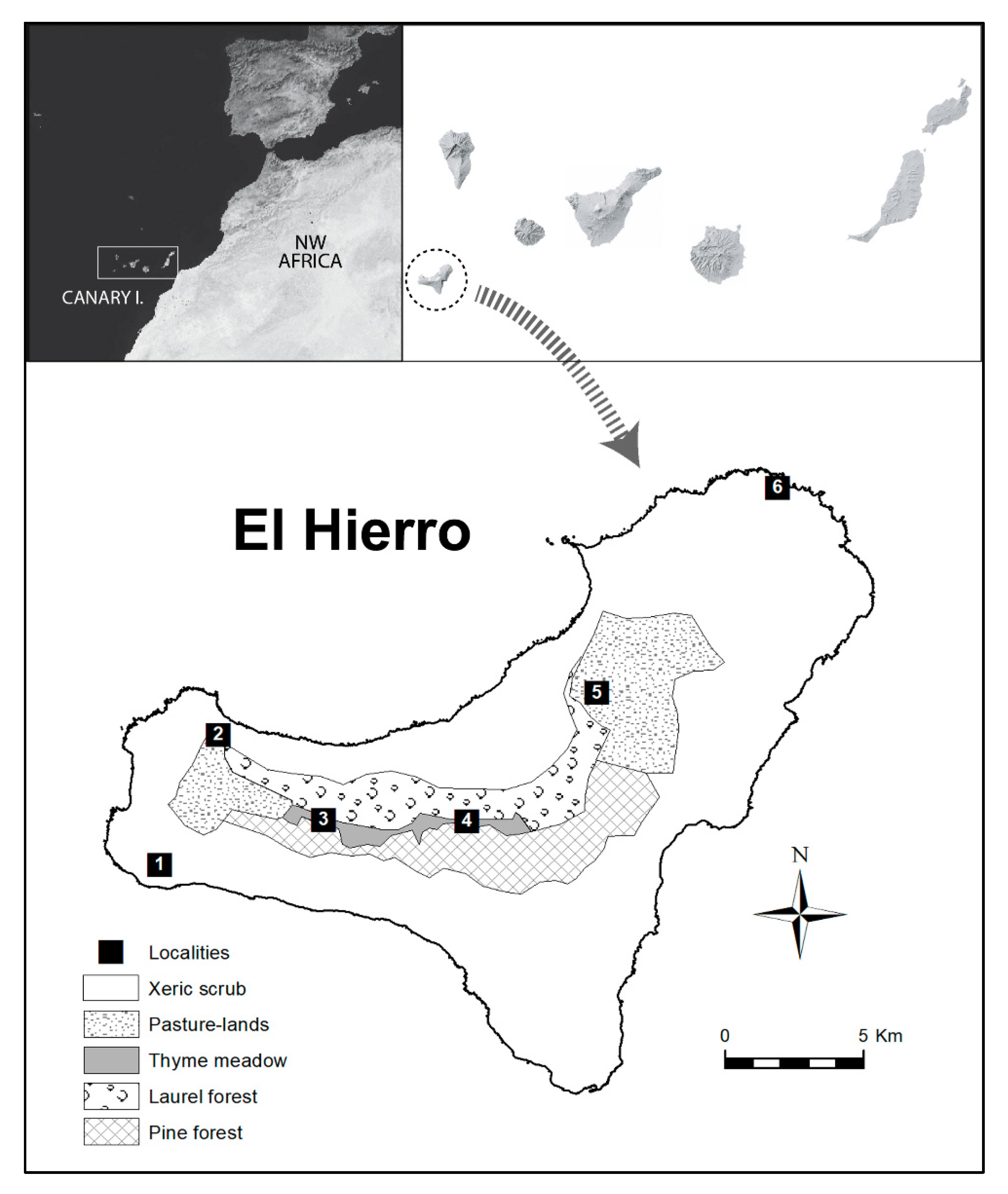
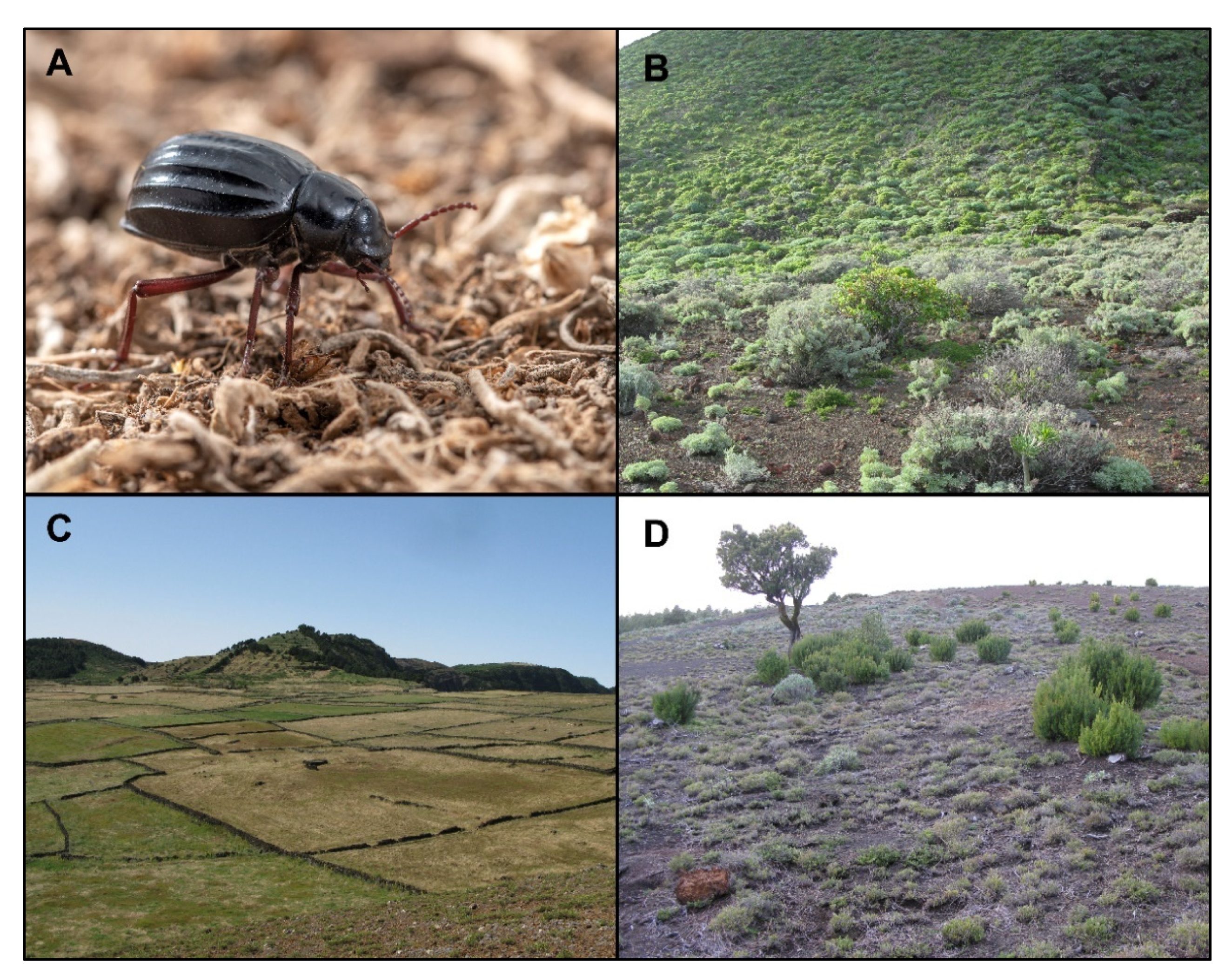
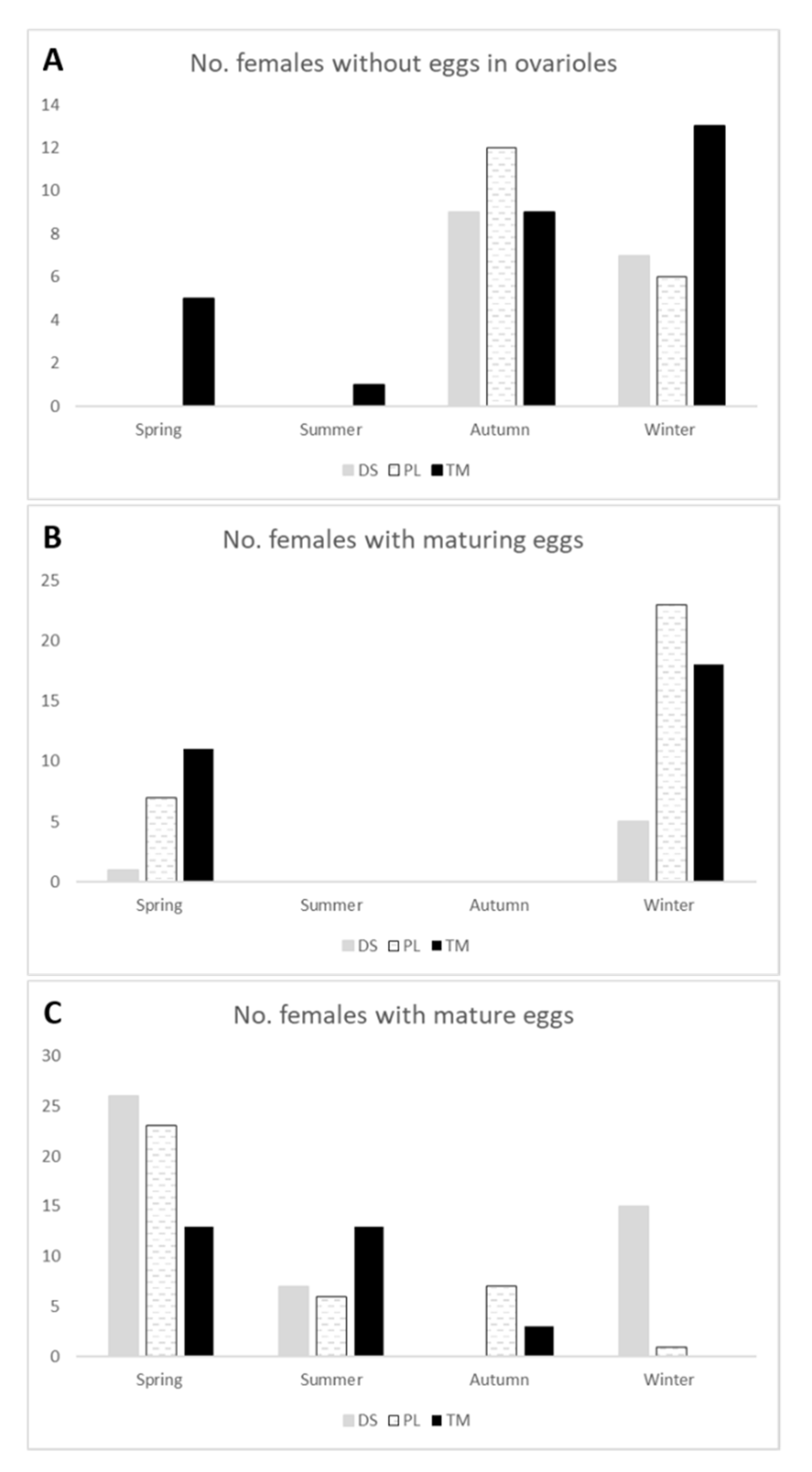

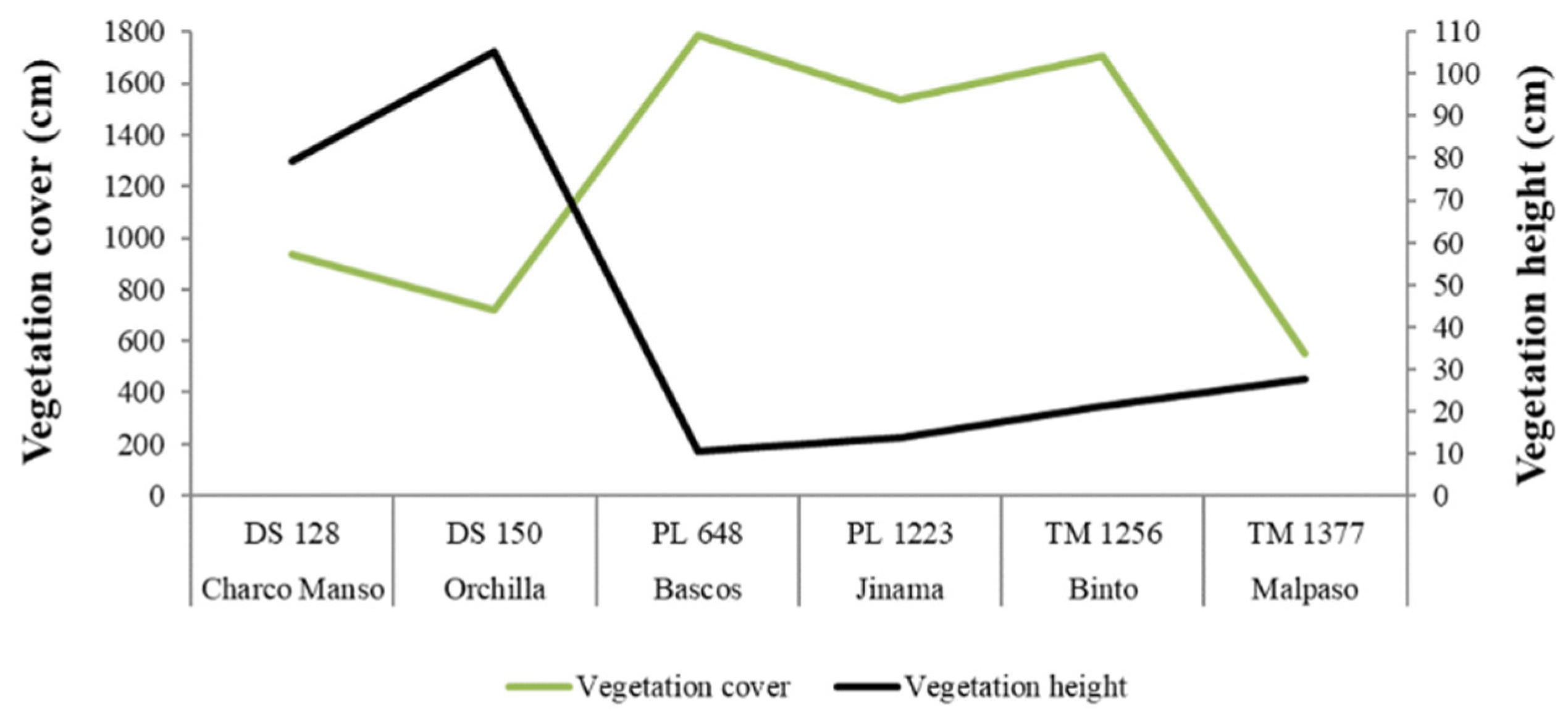
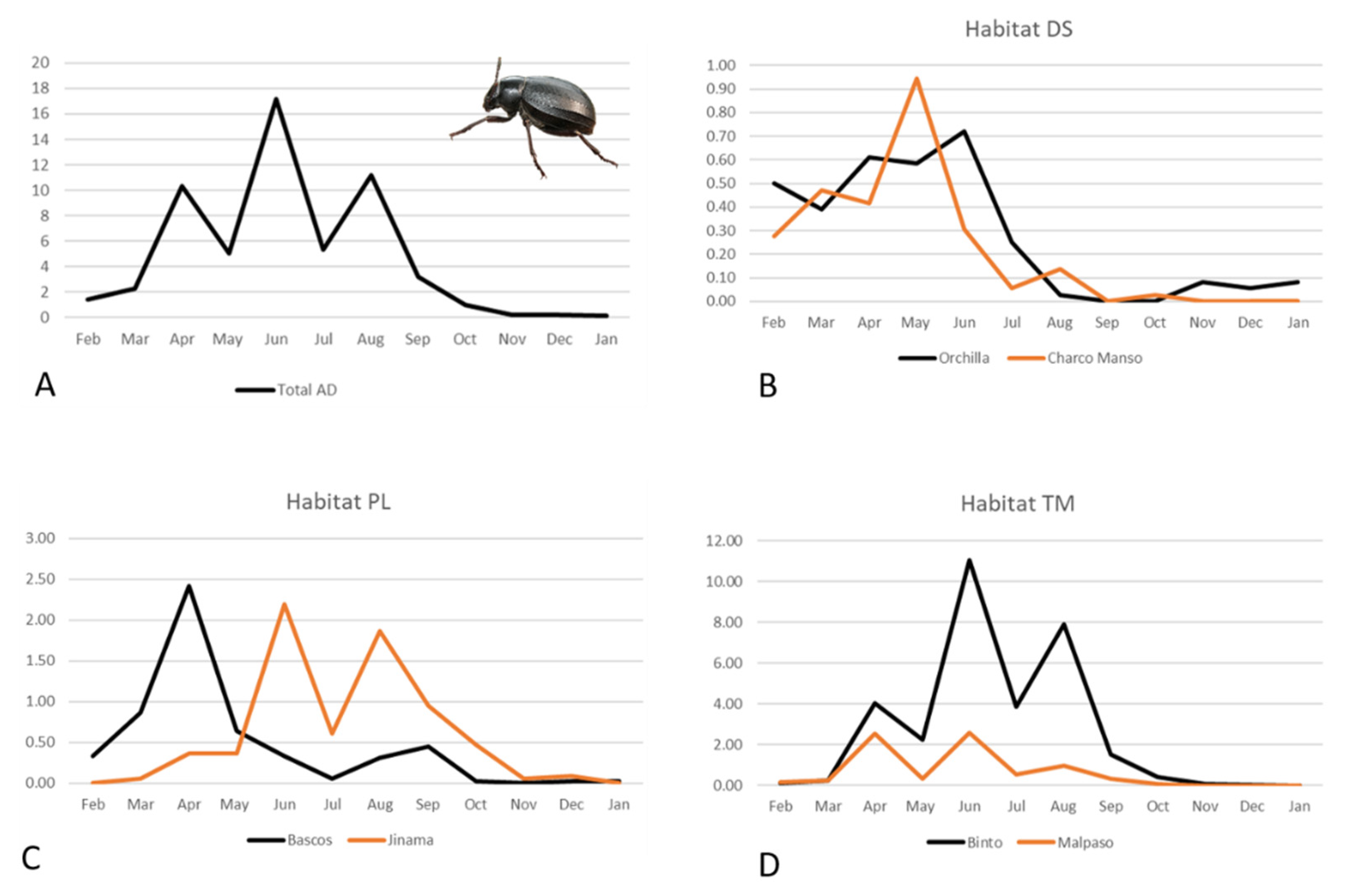
| Locality | Habitat Type | Altitude (m a.s.l.) | Annual Rainfall (mL/m2) | Mean Tmin (°C) (Range) | Mean Tmax (°C) (Range) |
|---|---|---|---|---|---|
| East region | |||||
| Charco Manso | DS | 128 | 240 | 15.9 (10–21) | 32.2 (28–37.5) |
| Jinama | PL | 1223 | 707 | 5.3 (1–11) | 25.7 (10–38) |
| Malpaso | TM | 1377 | 690 | 5.4 (1–10.5) | 29.1 (22–38) |
| West region | |||||
| Orchilla | DS | 150 | 177 | 15.1 (10–24.5) | 33.3 (26–43) |
| Bascos | PL | 648 | 344 | 10.1 (4.5–14.5) | 27.6 (21–37.5) |
| Binto | TM | 1256 | 563 | 9.1 (−1.5–7.5) | 33.3 (19.5–36.5) |
Publisher’s Note: MDPI stays neutral with regard to jurisdictional claims in published maps and institutional affiliations. |
© 2021 by the authors. Licensee MDPI, Basel, Switzerland. This article is an open access article distributed under the terms and conditions of the Creative Commons Attribution (CC BY) license (https://creativecommons.org/licenses/by/4.0/).
Share and Cite
López, H.; Hervías-Parejo, S.; Morales, E.; De La Cruz, S.; Nogales, M. Interpopulation Plasticity in a Darkling Beetle Life-History along a Whole Oceanic Island Altitudinal Gradient. Insects 2021, 12, 1137. https://doi.org/10.3390/insects12121137
López H, Hervías-Parejo S, Morales E, De La Cruz S, Nogales M. Interpopulation Plasticity in a Darkling Beetle Life-History along a Whole Oceanic Island Altitudinal Gradient. Insects. 2021; 12(12):1137. https://doi.org/10.3390/insects12121137
Chicago/Turabian StyleLópez, Heriberto, Sandra Hervías-Parejo, Elena Morales, Salvador De La Cruz, and Manuel Nogales. 2021. "Interpopulation Plasticity in a Darkling Beetle Life-History along a Whole Oceanic Island Altitudinal Gradient" Insects 12, no. 12: 1137. https://doi.org/10.3390/insects12121137
APA StyleLópez, H., Hervías-Parejo, S., Morales, E., De La Cruz, S., & Nogales, M. (2021). Interpopulation Plasticity in a Darkling Beetle Life-History along a Whole Oceanic Island Altitudinal Gradient. Insects, 12(12), 1137. https://doi.org/10.3390/insects12121137






